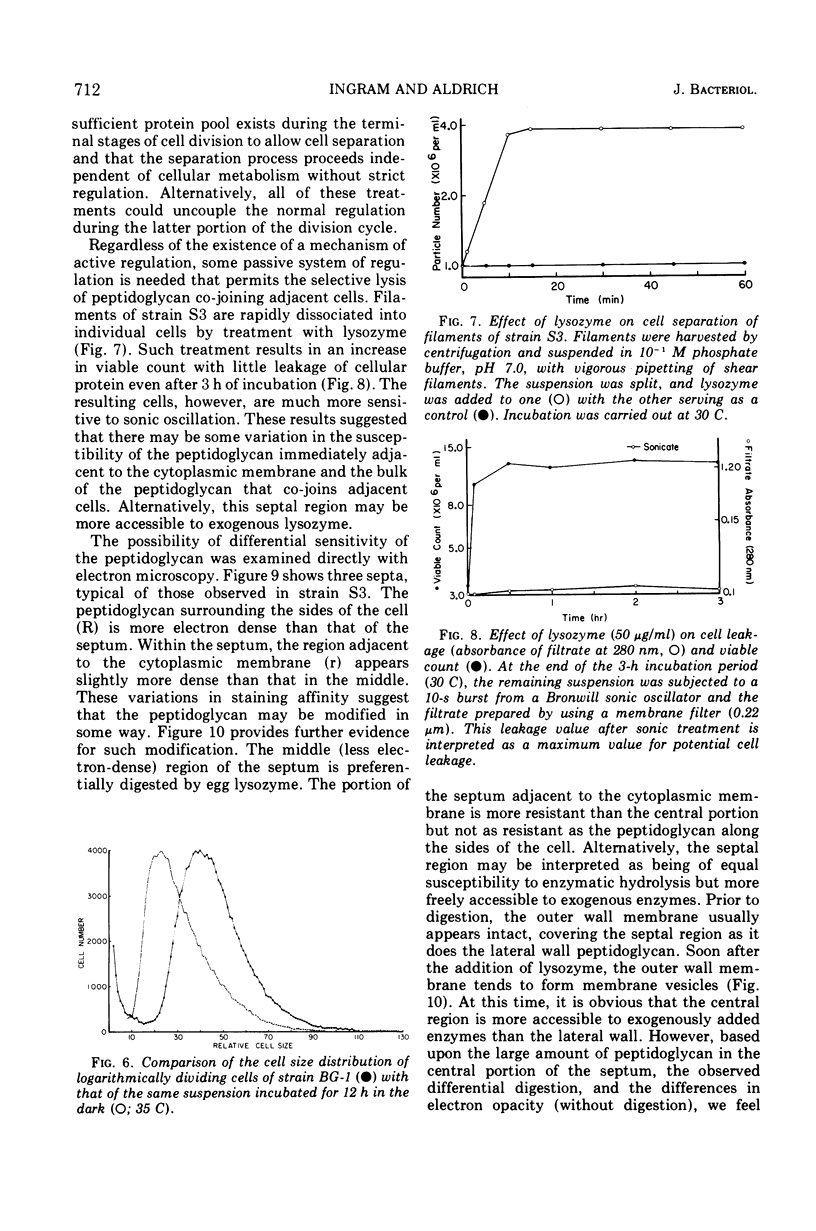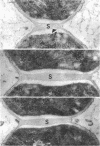Abstract
Autolysin-like enzymes appear to be responsible for cell separation in Agmenellum quadruplicatum. Mutants that are impaired in cell separation and grow as chains exhibit reduced cell lytic activity. Lysozyme, extracted autolysin, and antibiotics that affect peptidoglycan synthesis phenotypically suppress chain formation. Various aspects of the regulation of the cell separation process were also examined. Studies involving antibiotic inhibitors of macromolecular synthesis and general growth inhibitors provided no evidence for the active regulation of the cell separation process during the latter portion of the division cycle. Evidence was obtained, however, for the partial restriction of peptidogly-can hydrolysis by unknown secondary modifications. The thin electron-dense layer of peptidoglycan along the sides of cells was much more resistant to hydrolysis by egg-white lysozyme than was the septum between daughter cells. The middle portion of the septum was more sensitive than was the layer immediately adjacent to the cytoplasmic membrane. Under conditions that would not osmotically stabilize spheroplasts, lysozyme facilitates rapid cell separation in chain-forming mutants with little leakage of cellular protein or loss of viability.
Full text
PDF








Images in this article
Selected References
These references are in PubMed. This may not be the complete list of references from this article.
- Fan D. P. Autolysin(s) of Bacillus subtilis as dechaining enzyme. J Bacteriol. 1970 Aug;103(2):494–499. doi: 10.1128/jb.103.2.494-499.1970. [DOI] [PMC free article] [PubMed] [Google Scholar]
- Forsberg C., Rogers H. J. Autolytic enzymes in growth of bacteria. Nature. 1971 Jan 22;229(5282):272–273. doi: 10.1038/229272a0. [DOI] [PubMed] [Google Scholar]
- Higgins M. L., Shockman G. D. Procaryotic cell division with respect to wall and membranes. CRC Crit Rev Microbiol. 1971 May;1(1):29–72. doi: 10.3109/10408417109104477. [DOI] [PubMed] [Google Scholar]
- Ingram L. O., Fisher W. D. Selective inhibition of deoxyribonucleic acid synthesis by 2-deoxyadenosine in the blue-green bacterium Agmenellum quadruplicatum. J Bacteriol. 1972 Oct;112(1):170–175. doi: 10.1128/jb.112.1.170-175.1972. [DOI] [PMC free article] [PubMed] [Google Scholar]
- Ingram L. O., Thurston E. L., Van Baalen C. Effects of selected inhibitors on growth and cell division in Agmenellum. Arch Mikrobiol. 1972;81(1):1–12. doi: 10.1007/BF00715019. [DOI] [PubMed] [Google Scholar]
- Pooley H. M., Shockman G. D. Relationship between the location of autolysin, cell wall synthesis, and the development of resistance to cellular autolysis in Streptococcus faecalis after inhibition of protein synthesis. J Bacteriol. 1970 Aug;103(2):457–466. doi: 10.1128/jb.103.2.457-466.1970. [DOI] [PMC free article] [PubMed] [Google Scholar]
- REYNOLDS E. S. The use of lead citrate at high pH as an electron-opaque stain in electron microscopy. J Cell Biol. 1963 Apr;17:208–212. doi: 10.1083/jcb.17.1.208. [DOI] [PMC free article] [PubMed] [Google Scholar]
- Tomasz A. Biological consequences of the replacement of choline by ethanolamine in the cell wall of Pneumococcus: chanin formation, loss of transformability, and loss of autolysis. Proc Natl Acad Sci U S A. 1968 Jan;59(1):86–93. doi: 10.1073/pnas.59.1.86. [DOI] [PMC free article] [PubMed] [Google Scholar]





